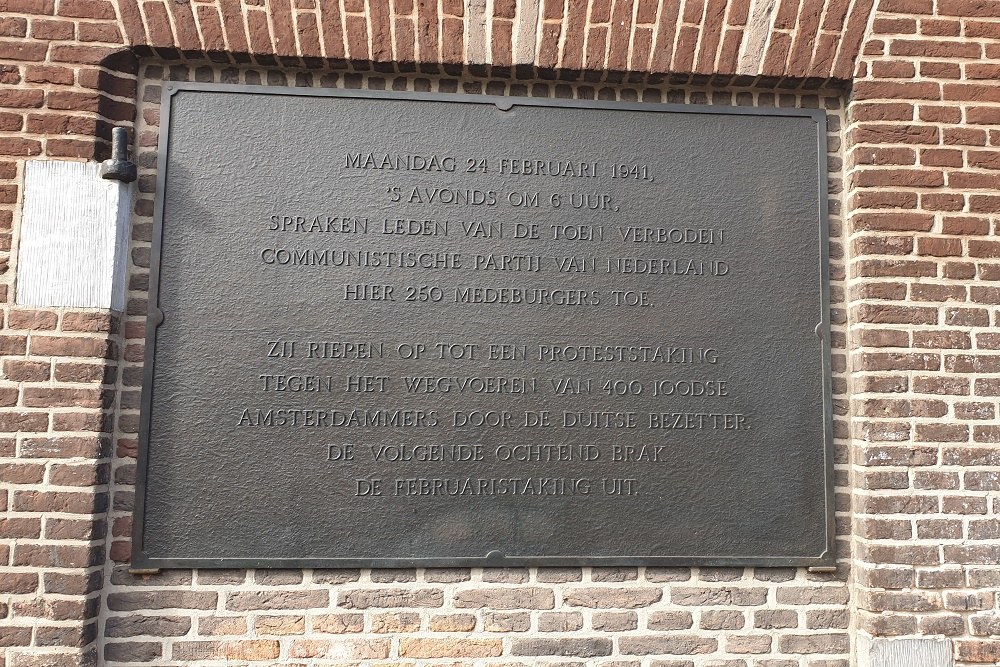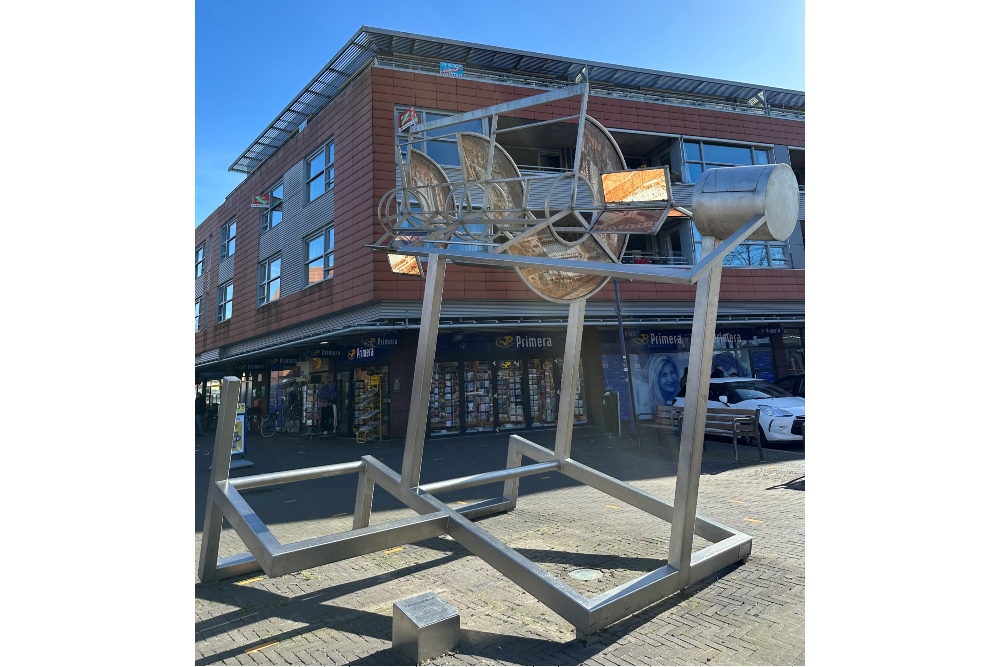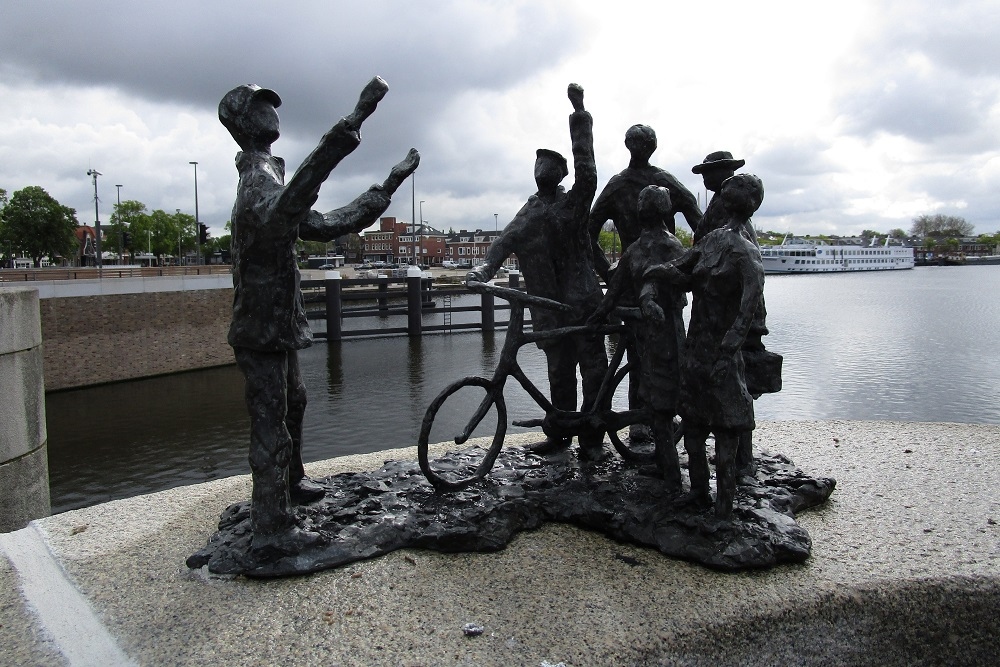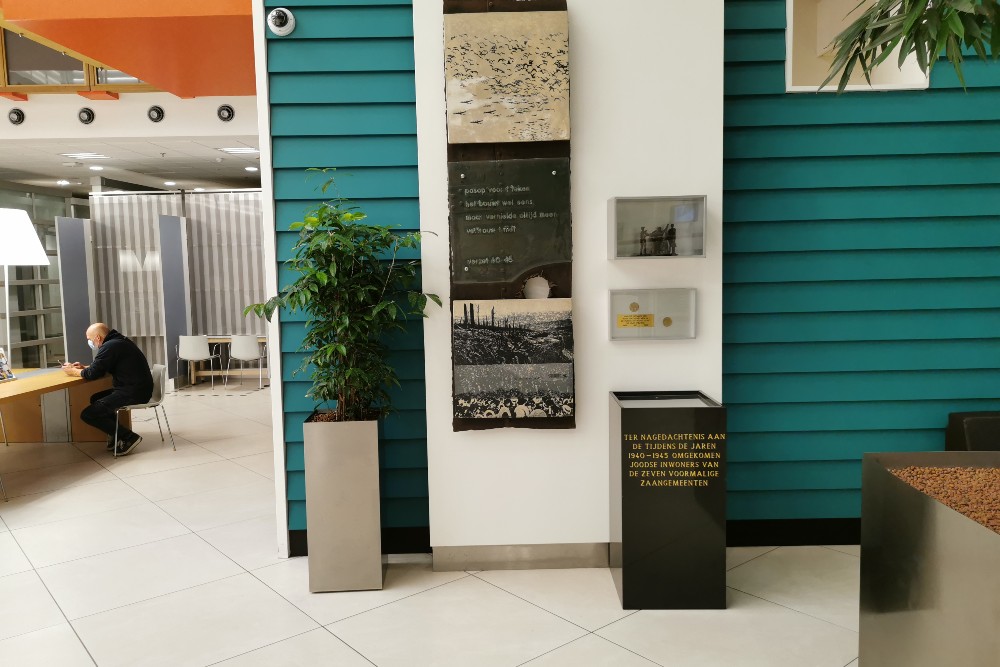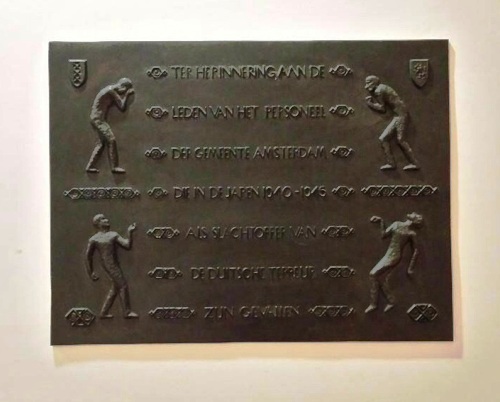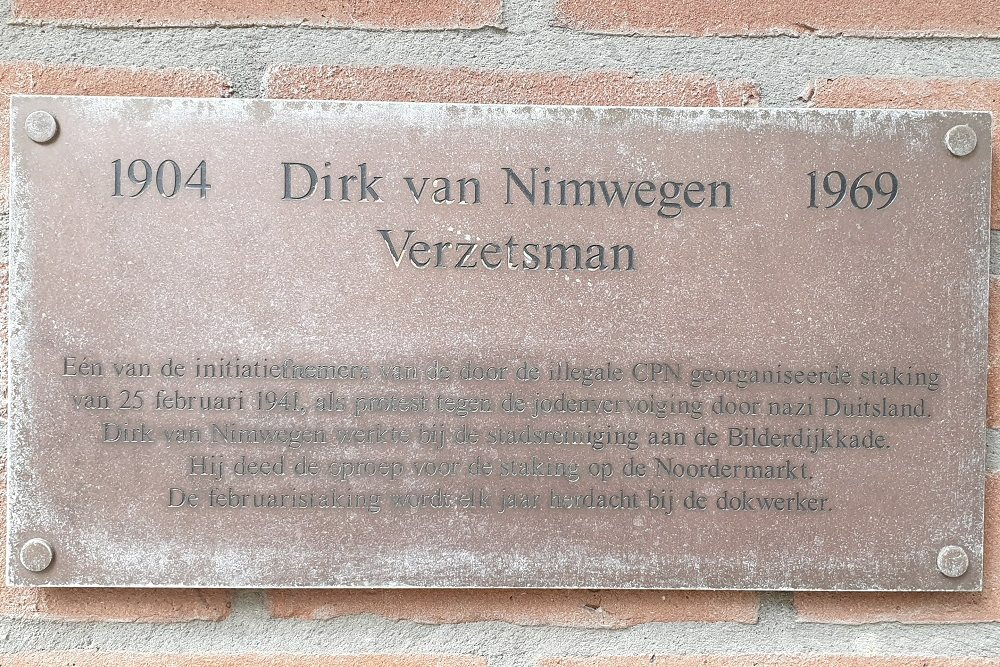Amsterdam offers resistance
February 25th, 2011 marked the seventy year anniversary of ten thousands of people from Amsterdam stopping work and going out into the streets to demonstrate against the German occupier after 427 young Jewish men were rounded up in razzias and taken to a concentration camp a few days before.
Like every year at the memorial near the Dokwerker at the Jonias Daniël Meyerplein, the following will be said: "When the German fury assaulted their Jewish fellow citizens, the citizens replied to this shameful act with a spontaneous strike. The people of Amsterdam were a shining example for the Netherlands." This is not false, but a lot is left unsaid. The massive strike in Amsterdam and several other cities was the only one in all of the occupied Europe between 1940 and 1945 - an event which can be called unique. But also unique in the sense of: once and never again!
The February strikes were an exception to the rule which applied to most of the Dutch people: careful adjustment to the ‘altered circumstances’. After the war, Amsterdam received the motto "Heroic, Determined, Merciful". Too good to be true? What did happen in that famous February month of 1941? The following contribution attempts to answer this question.
Definitielijst
- concentration camp
- Closed camp where people are being held captive that are considered to be anti- social, enemies of the state, criminal or unwanted individuals. These groups mostly do not get a fair trial or are condemned to doing time in a camp.
Images
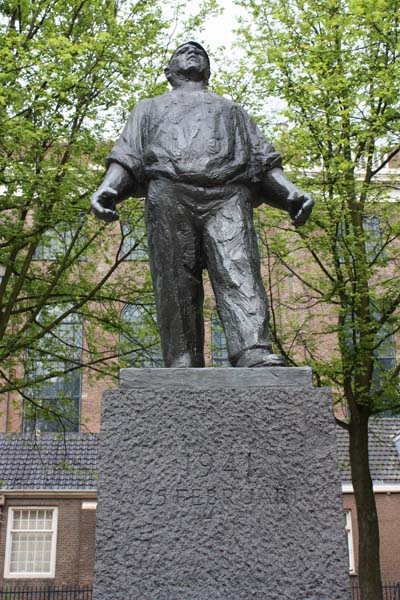 "De Dokwerker" at the Jonas Daniël Meijerplein in memory of the February strike. Source: Anita Stargardt.
"De Dokwerker" at the Jonas Daniël Meijerplein in memory of the February strike. Source: Anita Stargardt.The events prior to the strikes
Shortly after the German invasion of May 1940, if the Dutchmen were honest with themselves and each other, they had to admit: those Germans were not too bad. One could only say that they behaved correctly. Senior ladies experienced German soldiers standing up for them in the trams, and in shops they were extremely polite and paid every penny in cash. If a German soldier did act unseemly and an officer was informed, the soldier could expect sanctions. Looking back, it seemed ridiculous that, in those days in May, many of the better-off flushed their wine supplies through the sink and many had thought it wise to burn anti-German reading. Reich Commissioner Dr Arthur Seyss-Inquart - "the guy did not even have such an unpleasant face" - was frank in his inaugural: "Our hearts are not filled with hostility (-). There is nothing which could prevent us from treating one another with respect." That was very different from what the Belgians experienced in the invasion of 1914: the Germans moved through the country murdering and plundering, and in various places innocent citizens were shot just like that, sometimes dozens at a time. In the Netherlands of 1940, no such thing occurred. Life seemed to go on normally: the ball soon rolled over the soccer fields again and the lakes filled with sail boats. The leader of the NSB (National Socialist Movement in the Netherlands), Anton Mussert, who already imagined himself Hitler’s substitute in the Netherlands, was not enthroned.
But the honeymoon was soon over. Those who were not lead up the garden path could determine that the occupier wanted our country to become National Socialistic from the start. They organized it quietly, and with small, almost unnoticeable steps. The Nazi authorities especially targeted the Jews, as could be expected. For starters, they were discharged from air-raid defense. Next, their perception of religion was hit by prohibiting the age-old sacred slaughtering method. Ceremonial slaughtering was prohibited; animals had to anaesthetized first, from now on. But non-Jews were certainly not going to lose any sleep over slaughtering ceremonially or otherwise.
In the autumn of the first war year, officials were forced to sign a statement saying that "to the best of his knowledge, not he himself, nor any spouse or fiancée, nor one of his parents or grandparents had ever belonged to the Jewish community". The statement was signed by most of the 200,000 officials. Though they did not feel right in signing this ‘Aryan statement’, did the heads of the departments, the secretaries-general, not set the example by being the first to sign? The truth came out when in the beginning of 1941 all Jewish officials - about 2,500 - were "relieved from the observation of their office". When esteemed Jewish professors also became victim of this measure, Delft and Leiden saw such violent student actions that both institutions for higher education were closed. Jewish council members, six of them aldermen, and members of the Provincial Executive, had to give up their seats. Jewish doctors, midwives, lawyers and real estate agents were only allowed to serve Jewish clients, and Dutch people of Germanic blood could no longer be employed in Jewish families. This would only result in risk of infection for the superior Aryan race. Universities were no longer open to Jews and they were not allowed to show their face in cinemas. Because the disturbances which occurred there were mainly blamed on the representatives of the ‘Jewish race’.
A truly fatal regulation was issued on January 10th, 1941: on that day, all Jews living in the Netherlands had to be registered. Citizens were already considered Jews when they had only one Jewish grandparent and were not able to separate a church from a synagogue. The registration resulted in a list of over 160,000 branded people, and 137,000 of them had Dutch nationality. They received a yellow card in return for one guilder. A yellow card - no soccer fan would miss this metaphor. To continue the imagery: yellow would soon become red. The Jews had to be removed from the (social) playing field. Already in 1940, the preacher Dr Jan Koopmans from Amsterdam wrote in his anonymous brochure "Almost too late": "They will be taken away and they will be killed." (Just before the end of the war the preacher would be killed by a stray German bullet.) Slowly but surely, people started to realize what kind of process was going on: the Jewish blood, which was considered to be inferior, had to be cleared from the Dutch society.
Meanwhile, non-Jewish Dutch people also started to feel some pressure of the occupation. Soon they were only allowed to listen to "radio transmitters situated in areas under German control" and demonstrations on anniversaries of the House of Orange, like on the birthday of prince Bernhard (June 29th, 1940), would be punished with severity. But the thing that hit them harder: the Dutch Association of Trade Unions (NVV), the Social Democratic Workers’ Party (SDAP) and the associated VARA were placed under management of notable NSB figures; the Nationaal Jongeren Verbond (NJV, national youth association) was prohibited and the freemasons’ lodges were dissolved for being "spiritual pillars of world liberalism and plutocracy". The freedom of the Dutch people was over.
Feelings of hatred toward the occupier spread like straw fire through all parts of the Dutch population. The NSB, acting as an accomplice of the occupier, was ridiculed and scorned. Mussert’s party was able to sign up quite a few new members though; they were called "maybugs" by prewar party members: place-hunters and opportunists who thought they could profit from the ‘New Order’ after May 1940. Between January 1940 and December that year, the number of NSB members rose from 31,430 to about 50,000. Still, this membership figure was nothing compared to that of the Nederlandse Unie (Dutch union), founded in June 1940. In the turbulent February month of the second war year, their membership had already increased to 800,000. In large sections of the population, the Unie was considered the counterpart of the Mussert movement, but after the war it was not so unquestioned after all. The trio who founded the Unie would adapt too much to the new rule. The Germans soon thought otherwise; already in December 1942, the Nederlandse Unie, together with all other political organizations - with the exception of the NSB, of course - were discontinued.
Definitielijst
- invasion
- Armed incursion.
- Jews
- Middle Eastern people with own religion that lived in Palestine. They distinguished themselves by their strong monotheism and the strict observance of the Law and tradition. During World War 2 the Jewish people were ruthlessly persecuted and annihilated by the German Nazis. . An estimated 6,000,000 Jews were exterminated.
- Nazi
- Abbreviation of a national socialist.
- NSB
- National Socialist Movement. Dutch political party sympathising with the Nazis.
- raid
- Fast military raid in enemy territory
- synagogue
- Jewish house of prayer.
Images
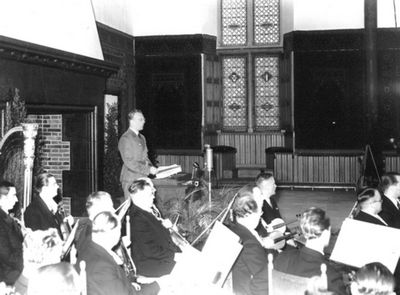 Seyss-Inquart reassures the Dutch people during his accession to office in the Ridderzaal. Source: ANP Fotoarchief.
Seyss-Inquart reassures the Dutch people during his accession to office in the Ridderzaal. Source: ANP Fotoarchief.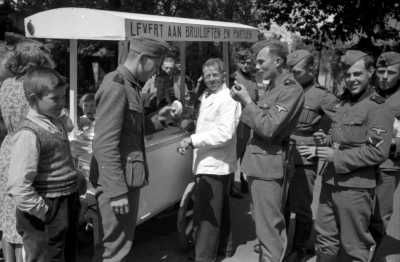 A peaceful scene in the summer of 1940: German soldiers eat ice cream in Amsterdam. Source: Beeldbank WO2.
A peaceful scene in the summer of 1940: German soldiers eat ice cream in Amsterdam. Source: Beeldbank WO2.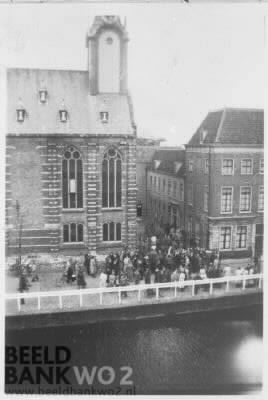 Student protest in Leiden on November 26th, 1940 against the laying off of Jewish professors. Source: Beeldbank WO2.
Student protest in Leiden on November 26th, 1940 against the laying off of Jewish professors. Source: Beeldbank WO2. ‘No admittance for Jews’ sign in the Vondelpark. Source: Beeldbank WO2.
‘No admittance for Jews’ sign in the Vondelpark. Source: Beeldbank WO2.Communists
The communists took a special position in the Dutch society in the first years of occupation. As the party had been faithfully connected to Moscow for decades, the nonaggression treaty between Germany and the Soviet Union forced party leader Paul de Groot to make a daring feat: from a fiercely antifascist and thus anti-German party, the Communist Party of the Netherlands (CPN) all at once became a party with no way of supporting the war started by the "British-French imperialism". The readers of the "Volksdagblad" were made understood good and proper that the fled Dutch government was responsible for "a five-day slaughter for capital interests". Thus: no support for the warfare of the Allies, but a "true neutrality", expressed in a correct attitude towards Germany. And precisely this party was prohibited by the German authorities as soon as July 1940. They reacted by being the first to immediately act in illegality to fight - not against the German people, but for a free, independent Netherlands, with the ultimate goal of world peace by breaking the imperialistic chains.
As soon as November 23rd, 1940 the first issue of the illegal communist magazine "De Waarheid" (the truth), which would take an important position in the underground press during all of the occupation, appeared. But in February 1941, the month when members of the CPN lighted the fuse of the powder keg and caused an enormous explosion of a hostile disposition toward the Germans, Paul de Groot wrote in "De Waarheid": "England is as bad as Germany." Life under the brute rule of the Nazis would soon prove stronger than this official theory, though. When the Germans invaded the Soviet Union in June 1941, the tables could be turned again.
Definitielijst
- imperialism
- The policy of a state to extend its territory by annexations of border areas of other states through colonisation. After World War 2 the term got more of an economic and cultural meaning rather than the actual domination of a territory.
- neutrality
- Impartiality, absence of decided views, the state of not supporting or helping either side in a conflict.
- Soviet Union
- Soviet Russia, alternative name for the USSR.
Images
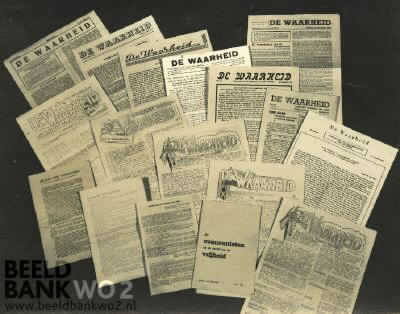 Copies of the (illegal) communist newspaper ‘De Waarheid’. Source: Beeldbank WO2.
Copies of the (illegal) communist newspaper ‘De Waarheid’. Source: Beeldbank WO2.Unemployment relief work
What fuelled the communist agitation, like always? Labor unrest. That soon arose when the unemployed were forced to accept "suitable labor" in Germany or to travel daily to and from the relief work camps in the province of Utrecht to develop moorlands and to restore defense and inundation works. The activities in these camps, the meager reward and the long working days - 13 to 14 hours including the train journey - soon became a source of major unhappiness. Some camps saw fights between workers and management, and in Amsterdam there were demonstrations for the City Labor Fair and the Ortskommandantur, the office of the local German commander. The CPN responded. In a pamphlet they wrote: "Keep up the fight! Do not leave the gentlemen alone! Fight strong. Be prepared to sacrifice. Carry on united and your first success, increase of support, will become a fact. Comrades, this Monday, both men and women take to the streets. It is the faith of your children we are dealing with!"
Hundreds answered the call - to a protest action secretly experienced as being aimed at the occupier. How the occupier reacted? Moderately. Arthur Seyss-Inquart and co still opined that it was possible to win the akin Dutch people’s sympathy for National Socialism. This is why diplomatic behavior - characterized by the government commissioner as ‘policy of conciliation’ - was a characteristic of the initial occupation policy. The omission of tough repercussions gave the laborers confidence. The well-known weapon of strike could possible achieve a lot. The February strike announced itself ominously.
Definitielijst
- February strike
- Anti-German demonstration in the Netherlands during 25 and 26 February 1941. Direct cause was the violent razzia by the WA and German soldiers in the Jewish quarter of Amsterdam.
- inundation
- “Latin: No bottom”. The deliberate flooding of land with the aim of stopping or hindering the advance of the enemy into a certain area.
- National Socialism
- A political ideology drawn up by Hitler based on the superiority of the German race, the leader principle and fierce nationalism that was fed by the hard Peace of Versailles. National socialism was anti-democratic and racist. The doctrine was elaborated in Mein Kampf and organised in the NSDAP. From 1933 to 1945 National socialism was the basis of totalitarian Germany.
- Socialism
- Political ideology aiming at slight or no class differences. Means of production are owned by the state. Evolved as a response to capitalism. Karl Marx tried to substantiate socialism scientific.
Images
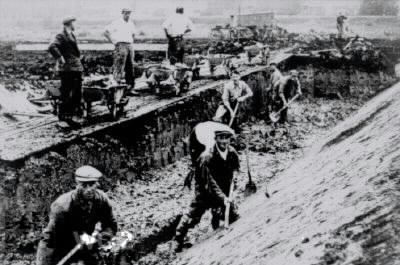 Unemployment relief workers do excavations. Source: Beeldbank WO2.
Unemployment relief workers do excavations. Source: Beeldbank WO2.Disturbances
Meanwhile the WA, the NSB’s paramilitary organization which before the war had not been allowed to show themselves in (black) uniform on public roads, started to "conquer the streets". The WA took Hitler’s storm troops, the SA (Sturmabteilung) as an example. In the beginning of the 1930’s, the SA played an important part in taking control through street terror. In cities like Amsterdam, Rotterdam, Utrecht and Arnhem, the WA lustily struck the audience when they showed even the slightest evidence of hostility. Members of the National Socialist Dutch Workers Party (the NSNAP of Knight Van Rappard), who aimed for the Netherlands to join the German Empire, also were happy to take part in the provocations. Besides the renowned boxing club "Maccabi", largely Jewish assault groups were built spontaneously, and they were not easily frightened.
The beginning of the anti-Semitic street terror dates back to December 14th, 1940. That Saturday night, about 70-80 WA members burst into Heck’s tearoom at the Rembrandtsplein. At that moment there were about 800 visitors inside, Jews and non-Jews, who soon became involved in violent fights with the attackers. Both sides dealt telling blows. At many places, canvassing ‘Union guys’ were molested by WA members, windows of Jewish businesses were smashed and furniture of houses lived in by Jews were destroyed. Windows of NSB members were smashed as well. In the first months of 1941, the situation would only worsen, especially surrounding the Waterlooplein, the heart of Jewish Amsterdam.
A welcome occasion to start beating people resulted in the obligation to place signs saying "JEWS NOT WELCOME" on cafés and such. When the owner of café "Alcazar" at the Thorbeckeplein refused to do so, the next day - February 9th, 1941 - a group of WA members stopped by. The café’s inventory was smashed to pieces. In an attempt to intervene, no less than 23 police officers were injured that day. That same day, sixteen young men were arrested, three of whom were photographed as ‘Jewish terrorists’ for the press, together with the primitive weapons they had used: brass knuckles, knives, sledges, axes, bottles of bleach, iron bars - put at their disposal by a non-Jewish scrap trader - and if necessary only with their own belt. German soldiers, passers-by, either looked on idly or sided with the black shirts when they were hard pressed. At the corner of the Waterlooplein, members of the Wehrmacht gladly helped when about 150 NSB members flogged out the visitors of a dancing.
The disturbances reached their climax on February 11th, 1941 when a company of the WA wanted to help a cornered SS member. The men found themselves across a majority of Jews and non-Jews. Confused, the WA member Hendrik Evert Koot lost his group. When they got sight of him, he was taken to the ground, hit in the face with iron bars and stabbed with a knife. Together with two comrades, he was admitted into the Binnengasthuis were he died three days later. Of course the NSB took advantage of the situation by staging Koot - "a righteous man, father of eight children" - as the victim of the National Socialist battle. "Fallen in the battle for People and Fatherland, as a victim of the Jewish populace, at the age of 42, like "The Black Soldier", wrote the representative of the WA. His funeral at "Zorgvlied" on February 17th, 1941 became a first-class propaganda event which saw two thousand rigidly marching comrades following the stretcher. The spectators at the sidewalks threw all sorts of curses at the participants. "Traitors!"
Definitielijst
- Jews
- Middle Eastern people with own religion that lived in Palestine. They distinguished themselves by their strong monotheism and the strict observance of the Law and tradition. During World War 2 the Jewish people were ruthlessly persecuted and annihilated by the German Nazis. . An estimated 6,000,000 Jews were exterminated.
- NSB
- National Socialist Movement. Dutch political party sympathising with the Nazis.
- propaganda
- Often misleading information used to gain support among supporters or to gain support. Often used to accomplish ideas and political goals.
- Sturmabteilung
- Storm detachment. Semi-military section of the NSDAP. Founded in 1922 to secure meetings and leaders of the NSDAP. Their increasing power was stopped during “The night of the long knives”, 29 and 30 June 1934.
- WA
- Abbreviation of defence department, assault groups of the NSB
- Wehrmacht
- German armed military forces, divided in ground forces, air force and navy.
Images
 Members of the WA of the NSB in Utrecht. Source: Beeldbank WO2.
Members of the WA of the NSB in Utrecht. Source: Beeldbank WO2. NSB members in the doorway of a café. The sign on the window says ‘Jews not welcome’. Source: Beeldbank WO2.
NSB members in the doorway of a café. The sign on the window says ‘Jews not welcome’. Source: Beeldbank WO2. Funeral of WA member Hendrik Koot at Zorgvlied in Amsterdam. Source: Beeldbank WO2.
Funeral of WA member Hendrik Koot at Zorgvlied in Amsterdam. Source: Beeldbank WO2.Jewish council
A few days before, on February 13th, 1941 a "Jewish Council" was installed on the initiative of the German authorities. The double chairmanship of this board, made up of twenty Amsterdam-Jewish dignitaries, was filled by Prof Dr David Cohen and the famous diamond merchant Abraham Asscher. In a communist manifesto both gentlemen were described as "Jewish big capitalists who valued their money more than the Jewish working people". The Jewish Council mainly served to guide the instructions of the occupying force to the Jewish people. They were also held responsible for the instructions’ strict execution. The Jewish Council decided to cooperate with the Germans as much as possible, "to avoid worse". The Council’s policy was especially aimed at supplying as many exemptions for employment in Germany as possible. Not to Westerbork and beyond - that was what mattered most. After the war, the ‘collaboration’ of the council resulted in serious reproaches and even exclusion from the Jewish circle for both chairmen.
The Judenrat’s first assignment was the publication of an appeal to the citizens to hand over all "weapons for firing, striking, stabbing or any other kind of weapon" to the police of Amsterdam. No punishment would be received by those who did so. The call was answered scantily; the stock was much less large than the Germans had expected it to be. The Jews’ corner, the Waterlooplein and its surroundings, with about 28,000 Jewish inhabitants and 24,000 non-Jews, was temporarily locked down.
But there was still turmoil in the city. On February 19th, a unit of the Sicherheitspolizei und Sicherheitsdienst (Sipo and SD) was ambushed when they barged in the ice cream parlor "Koco" for a search. The ‘parlor’ would be a hotbed of ‘troublemakers’. In defense against an expected WA attack, the owners, German-Jewish immigrants Cahn and Kohn, had put ready a 50 cm long metal bottle of ammonia. When they heard suspicious sounds outside, they turned open the valve, turned off the lights and got out of there. After they forced the door open, the German intruders experienced first-hand what it is like to inhale gas. They screamed out of pain and anger. That same night, Cahn and Kohn and their helpers were rounded up.
Definitielijst
- collaboration
- Cooperation of the people with the occupying forces, more generally spoken the term for individuals who cooperate with the occupying force is collaborator.
- Jews
- Middle Eastern people with own religion that lived in Palestine. They distinguished themselves by their strong monotheism and the strict observance of the Law and tradition. During World War 2 the Jewish people were ruthlessly persecuted and annihilated by the German Nazis. . An estimated 6,000,000 Jews were exterminated.
- Sipo
- ”Sicherheitspolizei”. Combination (since 1936) of the Gestapo and criminal police.
- WA
- Abbreviation of defence department, assault groups of the NSB
Images
 The Amsterdam Jewish Council in 1942. Source: Joods Historisch Museum.
The Amsterdam Jewish Council in 1942. Source: Joods Historisch Museum. Owners and staff of the ice cream parlor Koco in the store’s garden in the Rijnstraat. Source: Beeldbank WO2.
Owners and staff of the ice cream parlor Koco in the store’s garden in the Rijnstraat. Source: Beeldbank WO2.Round-ups
That was the limit for the occupier. The ‘Jüdische Frechheiten’ (impertinences) required reprisal. The day after the raid in the ice cream parlor, on February 20th, the Höhere SS- und Polizeiführer Brigadeführer Hanns Rauter, who had just returned from sick leave in Austria, took his measures. Though he had to admit that most disturbances were provoked "by the impossible behavior of the WA", which had acted "absolutely rampant", the Jews were still to blame according to the inimitable Nazi logic. "Juda has dropped the mask", echoed "Volk en Vaderland" after the German master. The German chief of police especially bore a grudge against the owners of ice cream parlor "Koco". The owners and their henchmen had not been careful in turning against representatives of the Great German Empire. "Eine Unverschämtheit!", an impertinence! Both owners of the ice cream parlor identified, Rauter took the position - supported by the government commissioner - that "dass man den Juden Cohn hängen soll". The Jew should not escape the hangman’s rope.
On March 3rd, E.I. Cahn was fusilladed at the age of 51. It was the first execution to be completed in the occupied Netherlands. The execution squad was in command of Untersturmführer (second lieutenant at the SS) Klaus Barbie, who was only tracked long after the war in France and sentenced to life in prison in 1987 for his crimes against humanity. Cahn’s business partner A. Kohn was sentenced to ten years in prison, but died soon after his deportation. After consulting with the highest chief of the SS and the police in Berlin, Reichsführer-SS Himmler, Hanns Rauter and Arthur Seyss-Inquart decided to round up and deport 425 Jews from Amsterdam between the ages of 20 and 35. Allegedly as hostages.
The round-up took place on the Sabbath, the for orthodox Jews free Saturday of February 22nd, 1941. What was supposed to be a "palace in time" (Heschel) for pious Jews, instead became a day of horror. In the morning hours, the old Jew corner, almost completely surrounded by water, was sealed. A large number of police vans, filled with about 600 "Grünen" (‘Greens’ after the dark green collar on the uniform of the Order police) drove to the Waterlooplein and the Jonas Daniël Meyerplein. The hunt was on. Men who fled anywhere were roughly seized by the German police men and forced into a throng with rifle butts. At a trot and urged on by gun shots in the air, they were driven to both squares. The Germans kicked and hit their victims wherever they could. The commanding officer sent his hound after the men. The hound - who took after his master - bit them in the legs and tore their trouser-legs apart. Abandoned women whose husbands were taken from their sides and little children who were roughly put down on the paving bricks let out harrowing cries. Many of the Dutch officers who had to witness the violent spectacle became very upset. The arrested Jews were flogged in large green cars with hits of rifle buts and taken to a prison camp in Schoorl: the first stop on the road which, through Buchenwald, would lead to the horrifying concentration camp Mauthausen.
It goes without saying that the events caused a wave of disgust and outrage among those who witnessed it or heard about it shortly after. This was especially true for Sunday, when the Sunday market, also visited by many non-Jews, took place. It turned out that the number of 425 ‘hostages’ was not reached the day before, because few Jews were out in the streets on Sabbath. So a second round-up was organized. The same events as Saturday occurred. "Again there were shouts, snarls, kicks and hits - and cries." A non-Jew wrote in his journal: "The indignities suffered by the Jews, were felt as Dutch indignities."
The Jewish countrymen may not have been known as the most likable population group, they were still a part of the country. Especially in Amsterdam, which the Jews - almost 80,000 in 1941 - had turned into MOKUM: hamakom alef, the first city after Jerusalem, or the "Jerusalem of the west". Since the 16th century, they had found refuge near the sea in the Low Countries. There they could live in freedom and practice their religion, even though here too they were restricted. "At the end of the interbellum period between both world wars, the Jews found themselves in an exceptional position, especially in government circles" (Michman/Beem). The first Jewish mayor in the Netherlands would not be appointed until after the second war.
Definitielijst
- concentration camp
- Closed camp where people are being held captive that are considered to be anti- social, enemies of the state, criminal or unwanted individuals. These groups mostly do not get a fair trial or are condemned to doing time in a camp.
- crimes against humanity
- Term that was introduced during the Nuremburg Trials. Crimes against humanity are inhuman treatment against civilian population and persecution on the basis of race or political or religious beliefs.
- interbellum
- “Latin: Between war”. Years between the Great War and World War 2.
- Jews
- Middle Eastern people with own religion that lived in Palestine. They distinguished themselves by their strong monotheism and the strict observance of the Law and tradition. During World War 2 the Jewish people were ruthlessly persecuted and annihilated by the German Nazis. . An estimated 6,000,000 Jews were exterminated.
- Mauthausen
- Place in Austria where the Nazi’s established a concentration camp from 1938 to 1945.
- Nazi
- Abbreviation of a national socialist.
- raid
- Fast military raid in enemy territory
- Volk en Vaderland
- People and Fatherland. The daily newspaper of the NSB.
- WA
- Abbreviation of defence department, assault groups of the NSB
Images
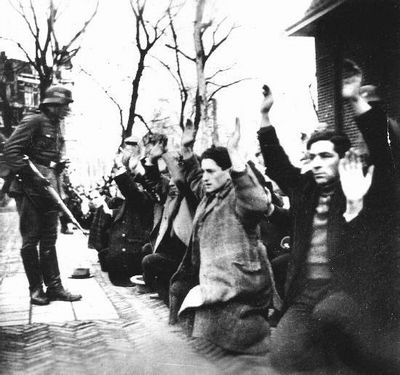 Razzia in the Jew area on February 22nd, 1941. Rounded up Jews at the Jonas Daniël Meijerplein in Amsterdam. Source: ANP Fotoarchief.
Razzia in the Jew area on February 22nd, 1941. Rounded up Jews at the Jonas Daniël Meijerplein in Amsterdam. Source: ANP Fotoarchief.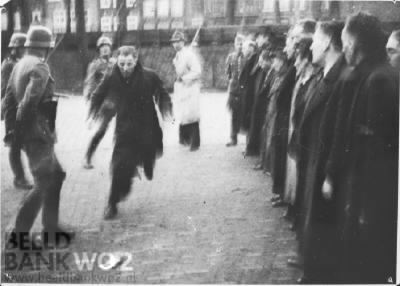 A Jewish man is hunted during the round-up. Source: Beeldbank WO2.
A Jewish man is hunted during the round-up. Source: Beeldbank WO2. The rounded up Jews are being transported to Schoorl to continue to Buchenwald and end up in Mauthausen. Source: Beeldbank WO2.
The rounded up Jews are being transported to Schoorl to continue to Buchenwald and end up in Mauthausen. Source: Beeldbank WO2.STRIKE! STRIKE!
After the round-ups in the Jew corner, Arthur Seyss-Inquart left for Germany on leave. Though the Sicherheitspolizei had heard rumors about an upcoming strike, they thought it was all talk. But it was not. In the weekend, the two municipal workers Piet Nak and Willem Kraan were able to win over the metropolitan CPN leaders for the idea of a massive strike.
The first task was to write up a manifesto for the ‘working people of Amsterdam’. It was designed by the national CPN manager Lou Jansen, who would be arrested and fusilladed in 1943. In the manifesto, two lines collided: one national, aimed at the German enemy, and one Marxist, aimed at the ‘class enemy’, the big business. "FIGHT PROUDLY FOR FREEING OUR COUNTRY!!!!" said the pamphlet. But above that it said: "ALSO MAKE YOUR DEMANDS FOR PAY INCREASE AND SUPPORT!!" (manifesto February strike). A communist ‘agitator’ had in mind a raise of no less than 25%! The (non-communist) inhabitant of Amsterdam did not pay much attention to the red rhetoric: the strike was exclusively about a protest against the Germans. The streetcar staff, the Sanitation department and the Public Works department were to go first in the strike. Because when employees of public services would strike en masse, that would determine the townscape and the employees of the private enterprise would, so they hoped, follow their lead. But duty was important to public officers. Authority was still authority, even in labor relations.
The first experiences of the early morning of Tuesday February 25th were not hopeful. The railway personnel at the switchyards did not care for a strike and some tram depots saw a great divide amongst drivers and conductors. A number of non-strikers managed to ride, while others were obstructed because determined strikers sat on the tracks. Meanwhile, the majority adopted a passive, expectant attitude. The Sanitation department only partly participated in the strike as well.
However, exceeding expectations was the response the strikers found at companies across the IJ. Around nine thirty, the grounds of the Nederlandsche Scheepsbouw Maatschappij and the Nederlandse Dok Maatschappij were pretty much abandoned and companies like Fokker, Kromhout and Verschure caught the strike virus. Almost all of the large and small factories, workshops and offices became empty, though there were followers who joined their colleagues towards the gateway without knowing exactly why... The arrival of the strikers at the IJ ferries resulted in a cheerful encounter; they cheered each other on and the very enthusiastic ones started singing the international and other socialist battle songs.
In the centre of the city, the verbal advertising for a strike against the Germans was also heard; more and more companies, including the Bijenkorf, stopped working and in many places they formed groups of sometimes singing protesters. HBS members, high school students who did not hesitate to close the school doors behind them, started choral readings: "ABCDEFG - Get rid of the krauts and the NSB." Driving streetcars were forced to stop, drivers and conductors were molested and in some cases the cars were pushed to their sides or at least derailed. A liberation mood took possession of the people of Amsterdam. The professor E.H. Kossman from Groningen: "The Amsterdam strike, extended from shipyard to factory, from warehouse to store, became a highly emotional eruption of intense grieve, of festive joy for one moment of regained liberation, of anger that did not seem so powerless at that moment as it had for many months".
Definitielijst
- February strike
- Anti-German demonstration in the Netherlands during 25 and 26 February 1941. Direct cause was the violent razzia by the WA and German soldiers in the Jewish quarter of Amsterdam.
- NSB
- National Socialist Movement. Dutch political party sympathising with the Nazis.
Images
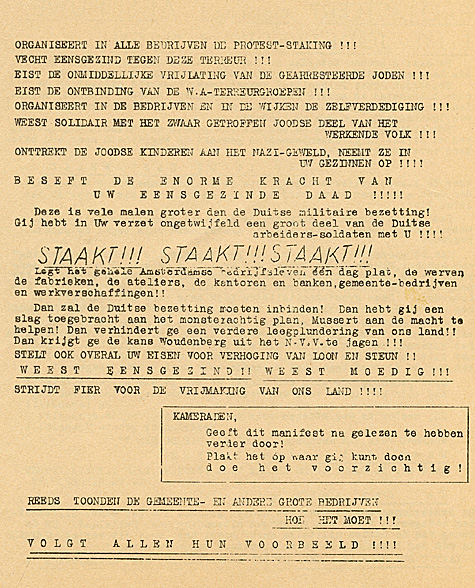 The back of the pamphlet calling for the strike. Source: Verzetsmuseum Amsterdam.
The back of the pamphlet calling for the strike. Source: Verzetsmuseum Amsterdam. Striking conductors and streetcar drivers in the Sarphatistraat of Amsterdam. Source: Beeldbank WO2.
Striking conductors and streetcar drivers in the Sarphatistraat of Amsterdam. Source: Beeldbank WO2.Passive police
The mainly passive stand of the police of Amsterdam had a great influence. Officers often limited themselves to the request: "Ladies and gentlemen, please continue walking!" This changed a bit in the beginning of the afternoon when two police inspectors ordered to make charges to scatter the thousands of people who gathered at the Noordermarkt for a large demonstrative meeting. It was better, the police officers reasoned, to drive the protesters apart with their ‘own people’, than to leave this matter to the Germans who surely acted much more roughly, and were already spotted in the area. Hanns Rauter had his Polizei Bataillon 254, which was stationed in the capital city and consisted of about 500 men, put the bayonet on the gun to drive the gathering apart. Furthermore he directed two battalions of the SS-Totenkopf Regiment, former camp guards, to the capital city, and he called in 250 military policemen.
Meanwhile, Dr H. Bömcker, authorized agent (Beauftragter) of the government commissioner for the city of Amsterdam, threatened Mayor Dr W. de Vlugt with the "roughest measures" when the disturbances would not be stopped. The man did not know what to do besides urging the municipal employees to get back to work, with threats of punishment. The chairmen of the Jewish Council were told - it was the same old story - that the Jews were responsible for the strike. They should be prepared that another 300 Jews would be arrested if the strike was not cancelled before the next day. Through a posted up Bekanntmachung/Announcement and the bringing in of speaker trucks, the citizens were informed that no one was to be out in the streets after seven thirty in the evening. This also applied to Hilversum and Haarlem, were the strike had expanded, while people massively stopped working in Weesp as well.
"Rough measures" were not taken that first day of strike. In many places, the Germans positioned troops, but apparently the commanders were told not to act to harshly. In the Jordaan, a police van full of Grüne Polizei let a parade of strikers pass freely. Only six people were injured that day and four of them had to be admitted into the hospital.
The leaders considered the strike to be an overwhelming success. It exceeded all their expectations. They wanted more of that! And thus a manifesto appeared which announced a national strike for March 6th. The Germans soon found a copy of the leaflet.
Definitielijst
- bayonet
- Pointed weapon that can be placed at the end of a rifle and used in man-to-man combat.
- Grüne Polizei
- Green Police, nickname – due to their green uniforms – for the Ordnungspolizei (Order Policy) and which is the common denominator for local policy units tasked with exercising regular policy responsibilities during Nazi-Germany from 1936 to 1945.
- Jews
- Middle Eastern people with own religion that lived in Palestine. They distinguished themselves by their strong monotheism and the strict observance of the Law and tradition. During World War 2 the Jewish people were ruthlessly persecuted and annihilated by the German Nazis. . An estimated 6,000,000 Jews were exterminated.
- Regiment
- Part of a division. A division divided into a number of regiments. In the army traditionally the name of the major organised unit of one type of weapon.
- Totenkopf
- “Death’s head”. Symbol that was used by the SS. Also the name of an SS Division.
Images
 The Amsterdam Mayor W. de Vlugt greets Seyss-Inquart on August 5th, 1940. Source: Beeldbank WO2.
The Amsterdam Mayor W. de Vlugt greets Seyss-Inquart on August 5th, 1940. Source: Beeldbank WO2.The second day
On the second day, the strike gradually stopped. Many of the municipal employees caved under the threat of discharge and punishment. Only in Public Works did they stand firmly a while longer. But in the City Sanitation Department, nearly everyone got back to work and of the 775 street car employees who participated in the strike the day before, about 500 drove again. The public gave the ‘scabs’ a hard time, so authorities decided to give each street car a security guard: either a Dutch or German policeman or a military policeman. Contrary to the municipal services, the strike in the private enterprise remained unshaken for hours, though many concluded that the strike was ending soon when the street cars appeared in the scene again. But in surrounding places, the strike was only just starting; the number of strikers in Hilversum rose to 2,500.
The Germans were now determined to break up the resistance, with all violence if necessary. Police vans crossed the city centre, soldiers threw grenades at assembling citizens and fired away, though mostly they did not aim directly at people. In the City Sanitation Department at the Bilderdrijkkade, they threw garage doors open and randomly shot inside with automatic weapons. Nevertheless without making many victims. The Dutch police acted as discreetly as possible, also when they had no choice but to obey the Germans’ order to drive apart a ‘large gathering’ in the Potgieterstraat. But as far as researchers could determine afterward, they never took the initiative.
The intimidating German display of power was effective. People were frightened. Rumor had it that hospitals were filled with hundreds of dead and wounded. The number of casualties would be 700. In reality, only nine people were killed that day, and there were 21 people with minor injuries and 24 with serious injuries. The leaders of the strike had always said that the strike would end on the 26th. The day after, Amsterdam got back to work. Enough was enough.
Definitielijst
- resistance
- Resistance against the enemy. Often also with armed resources.
Aftermath
Of course this was not the end to the story. The Sicherheitsdienst had sufficient evidence of the communists’ part in the revolt to arrest a large number of them. After four communists were already captured on February 27th, the following two months another 22 ‘high officials’ and about 90 lower officials were arrested. 22 of them were prosecuted. Three communists were sentenced to death and on March 11th they were fusilladed, together with fifteen resistance fighters known as the ‘Geuzen’ who had been captured before. As a result of their execution, Jan Campert wrote his largely spread illegal and impressive poem "De Achttien Doden". About two hundred municipal officials were arrested at their working places and locked up in the Lloyd Hotel at the Handelskade. Almost all of the people arrested were released after a few weeks. Among them were Piet Nak and D. van Nimwegen, who were known as the biggest agitators.
But it did not stop at arresting people. The mayors of Amsterdam, Haarlem and Zaandam were removed from office and replaced by deutschfreundliche gentlemen. Amsterdam, Hilversum and Zaandam received fines of fifteen, two point five and half a million guilders respectively, to be claimed of inhabitants who were taxed for over f.10,000.-. Though popular historiography likes to recount how the strike was "ended in bloodshed", it should be said, with the knowledge of after the war, that the reprisals were mild in comparison to the later actions in Lidice, Oradour and Putten, where hundreds of innocent civilians were brutally murdered.
The result was a growing "unjustified sense of security for the Jews; the Germans would now think twice about treating the Jews in the Netherlands the same as elsewhere, now that the entire population stood up against that. Especially the eternal optimist like Asscher was firmly convinced of that." (Michman/Beem) Was it not a positive sign that Hanns Rauter did not execute his threat of arresting another 300 Jews? Asscher underestimated the Nazis’ bloodlust - like almost anyone did - and overestimated the Dutch people’s solidarity. The February strike was more of a general protest against the German oppressor than a manifesto of solidarity with the Jews. As far as the strike showed compassion for the Jewish part of the population, it was also its last manifesto. After that, there would be (relatively) few who would venture their lives by accommodating Jews.
All at once, the events had shown the Dutch people the true colors of the occupier. On March 13th, Arthur Seyss-Inquart made a speech in the Concertgebouw in Amsterdam for Parteigenossen, members of the NSDAP residing in the Netherlands. He wanted, so he said, to speak frankly about the Judenfrage. He called the Jews "enemies he could neither make a truce nor peace with". And he continued: "Wir werden die Juden schlagen wo wir sie treffen können und wer mit ihnen geht, der wird eben dann mitgetroffen." ("We will hit the Jews where we can hit them and whoever sides with them will meet with the same fate.") Both Jews and non-Jews were warned. The government commissioner of the inaugural lecture in the Ridderzaal had put down his sheep’s clothing and shown his true self: a wolf. A deputy of the Führer, who had nothing better to do than slavishly complying with his great hero’s wishes.
Definitielijst
- February strike
- Anti-German demonstration in the Netherlands during 25 and 26 February 1941. Direct cause was the violent razzia by the WA and German soldiers in the Jewish quarter of Amsterdam.
- Führer
- German word for leader. During his reign of power Adolf Hitler was Führer of Nazi Germany.
- Jews
- Middle Eastern people with own religion that lived in Palestine. They distinguished themselves by their strong monotheism and the strict observance of the Law and tradition. During World War 2 the Jewish people were ruthlessly persecuted and annihilated by the German Nazis. . An estimated 6,000,000 Jews were exterminated.
- Lidice
- Village in Czechoslovakia which was demolished in 1942 as a retaliation against the assassination of Reinhard Heydrich . The men were brought before a firing squad while the women were sent to concentration camps.
- resistance
- Resistance against the enemy. Often also with armed resources.
Images
Mauthausen
The 427 rounded-up Jews were first taken to camp Schoorl. 389 of them were transported to the concentration camp Buchenwald a few days later. After several months, 77 of them had already passed away. There was a large amount of notices starting with: "From Buchenwald we received word..." The Germans did not like that in the least, so through the Jewish Council they prohibited such obituary notices. As if the number of fatalities was not high enough yet, the Jews from Amsterdam were transported from Buchenwald to the even more infamous camp Mauthausen in May ‘41, where they were put to work in the stone quarries. In the fall of that same year, almost all of them had died. Only one man escaped the dance of death: Max Nebig. He was, still under anesthetics from a surgery, in the quarantine department of Buchenwald on the day that the ‘Dutchmen’ were transferred to Mauthausen. Saved as if by a miracle, he survived the war, especially thanks to his fellow prisoners in the hospital barracks who repeatedly had him declared untransportfähig (not able to be transported) when there came questions from Mauthausen about Nebig...
Definitielijst
- Buchenwald
- Concentration camp established in 1937 near the city of Weimar.
- concentration camp
- Closed camp where people are being held captive that are considered to be anti- social, enemies of the state, criminal or unwanted individuals. These groups mostly do not get a fair trial or are condemned to doing time in a camp.
- Jews
- Middle Eastern people with own religion that lived in Palestine. They distinguished themselves by their strong monotheism and the strict observance of the Law and tradition. During World War 2 the Jewish people were ruthlessly persecuted and annihilated by the German Nazis. . An estimated 6,000,000 Jews were exterminated.
- Mauthausen
- Place in Austria where the Nazi’s established a concentration camp from 1938 to 1945.
Images
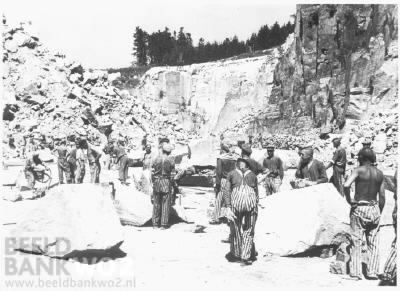 Prisoners do hard labor in the stone quarry of Mauthausen. Source: Beeldbank WO2.
Prisoners do hard labor in the stone quarry of Mauthausen. Source: Beeldbank WO2.Hit in the face
Dr Lou de Jong wondered whether the February strike affected the occupier’s attitude towards the Jews. His answer was: "Not insofar that we know of any anti-Jewish measures of which one could claim that it was a result of the strike, or of which one could show that it would not have been taken without the strike." Ben Sijes (RIOD) concluded: "The February strike did not result in any tangible results for the population." It is true that it is hard to draw another conclusion, though one can presume that the strike stirred up the resistance spirit. Exactly one month after the strike, the Zentrale für jüdische Auswandering (Central Office for Jewish Emigration) was set up in de Van Eeghenstraat in Amsterdam; as an example for other occupied areas. The machinery of death was started and went at full speed as from 1942.
The February strike was a hit in the face of Arthur Seyss-Inquart who had to acknowledge that his politics of the "soft line" - as he saw it - had failed completely. He had pursued that policy by order of Berlin, but in February 1941 it became obvious to him that the Dutch people would not be lead to the National Socialist utopia with ‘rat catcher’s fiddling’ and obligingness. Seyss was very disappointed and disheartened, his friend and close colleague dr. F. Wimmer, Generalkommissar for administration and justice, said seven years later. He concluded: when ‘die Holländer’ would not listen, they would have to feel. The kid gloves were set aside for the fist and rod of iron. That the Widerstand, the resistance, might increase was something he took for granted. Hanns Rauter - about whom he said nothing - would have his methods for that. The Dutch people who would resist against the German Empire in the next few years, would harshly be introduced to that.
Increasingly darker clouds were gathering over our country. The Netherlands would suffer a horrible reign of terror. But both men from Austria, who practically embodied the Nazi tyranny, Seyss-Inquart and Rauter, did not escape the punishing justice. Seyss-Inquart was hanged after the "trial of Neurenberg" on October 16th, 1946. Rauter was sentenced to death by the Bijzonder Gerechtshof in ‘s-Gravenhage on May 4th, 1948. Just before his execution, Seyss-Inquart would have said: "I know my rope is made of Dutch hemp."
Definitielijst
- February strike
- Anti-German demonstration in the Netherlands during 25 and 26 February 1941. Direct cause was the violent razzia by the WA and German soldiers in the Jewish quarter of Amsterdam.
- Jews
- Middle Eastern people with own religion that lived in Palestine. They distinguished themselves by their strong monotheism and the strict observance of the Law and tradition. During World War 2 the Jewish people were ruthlessly persecuted and annihilated by the German Nazis. . An estimated 6,000,000 Jews were exterminated.
- Nazi
- Abbreviation of a national socialist.
- resistance
- Resistance against the enemy. Often also with armed resources.
Images
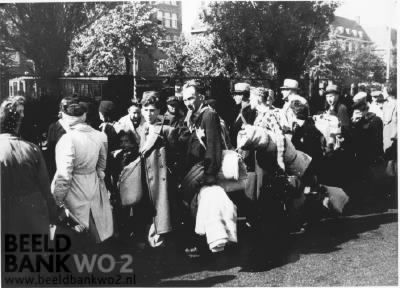 Jews at the sports complex of the Olympiaplein in Amsterdam await their deportation to camp Westerbork, June 20th, 1940. Source: Beeldbank WO2.
Jews at the sports complex of the Olympiaplein in Amsterdam await their deportation to camp Westerbork, June 20th, 1940. Source: Beeldbank WO2. Mien ten Dam-Pooters talks about the February strike. Source: Verzetsmuseum.
Mien ten Dam-Pooters talks about the February strike. Source: Verzetsmuseum.Information
- Article by:
- Henk van der Molen
- Translated by:
- Kim van Dijk
- Feedback?
- Send it!
Related sights
Related books
Sources
- BLOM, J.C.H., Crisis, Bezetting en Herstel, Nijgh en Van Ditmar BV Universitaire Pers, Rotterdam/Den Haag, 1989.
- BLOM, J.C.H. e.a., Geschiedenis van de Joden in Nederland, Balans, Amsterdam, 1995.
- HERZBERG, A.J., Kroniek der Jodenvervolging 1940-1945, Meulenhoff, Amsterdam.
- HIRSCHFELD, E.H., De Lage Landen 1780-1980 deel III, Elsevier, Amsterdam/Brussel.
- JONG, L. DE, Het Koninkrijk der Nederlanden in de Tweede Wereldoorlog 4, Staatsuitgeverij, Den Haag, 1969.
- MOORE, B., Slachtoffers en overlevenden, Bert Bakker, Amsterdam, 1998.
- NEUMAN, H. J., Arthur Seyss-Inquart, Uitgeverij Ambo n.v., Utrecht.
- ONBEKEND, Documentaire Nederland en de Tweede Wereldoorlog deel 13, Waanders uitgevers, Zwolle.
- PRESSER, J., Ondergang, Aspekt, Soesterberg, 2005.
- SEIJES, B.A., De februaristaking 25-26 februari 1941, H.W.J. Becht, Amsterdam.
- WARMBRUNN, W., Bezetting en collaboratie, H.J.W. Becht, Haarlem.
- WICHERT, M., De Nederlandse Unie, Prometheus, Amsterdam, 1999.



